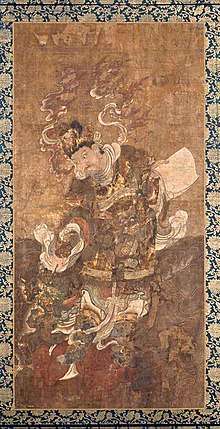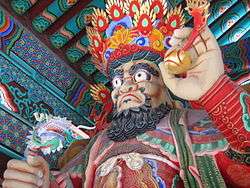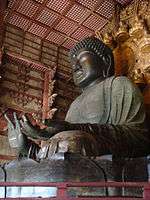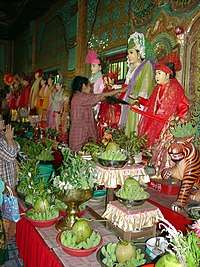Virūpākṣa
Virūpākṣa (Sanskrit; Pali: Virūpakkha; traditional Chinese: 廣目天王; simplified Chinese: 广目天王; pinyin: Guǎngmù Tiānwáng; Japanese: 広目天 Kōmokuten) is a major deity in Buddhism. He is one of the Four Heavenly Kings and a dharmapala.
| Virūpākṣa | |
|---|---|
| Sanskrit | विरूपाक्ष
Virūpākṣa |
| Pāli | विरूपक्ख
Virūpakkha |
| Chinese | 廣目天王
(Pinyin: Guǎngmù Tiānwáng) |
| Japanese | 広目天
(romaji: Kōmokuten) |
| Korean | 광목천왕
(RR: Gwangmok Cheonwang) |
| Thai | ท้าววิรูปักษ์
Thao Wirupak |
| Tibetan | སྤྱན་མི་བཟང Wylie: spyan mi bzang THL: Chen Mi Zang |
| Vietnamese | Quảng Mục Thiên |
| Information | |
| Venerated by | Theravāda
|
| Attributes | Guardian of the West |
Names
The name Virūpākṣa is a Sanskrit compound of the words virūpa (ugly; deformed) and akṣa (eyes). Buddhaghosa interpreted virūpa as also meaning "various", which lends to the understanding that Virūpākṣa is endowed with clairvoyance.[1] Other names include:
- traditional Chinese: 廣目天王; simplified Chinese: 广目天王; pinyin: Guǎngmù Tiānwáng; Korean: 광목천왕 Gwangmok Cheonwang; Vietnamese: Quảng Mục Thiên, a calque of Sanskrit Virūpākṣa
- Traditional Chinese: 毘楼博叉; pinyin: Bílóubóchā; Japanese: Birubakusha; Korean: 비류박차 Bilyubagcha; Vietnamese: Tỳ Lưu Bác Xoa. This is a transliteration of the original Sanskrit name.
- Tibetan: སྤྱན་མི་བཟང, Wylie: spyan mi bzang , THL Chen Mi Zang, "Ugly Eyes", a calque of Sanskrit Virūpākṣa
- Thai: ท้าววิรูปักษ์ Thao Wirupak is an honorific plus the modern pronunciation of Pali Virūpakkha.
Characteristics
Virūpākṣa is the guardian of the western direction. He lives on the western part of Sumeru. He is leader of the nāgas and pūtanas.
He possesses the divine eye (Skt. divyena cakṣuṣā), which allows him to see great distances as well as the karma of sentient beings.
Theravāda
In the Pāli Canon of Theravāda Buddhism, Virūpākṣa is called Virūpakkha. Virūpakkha is one of the Cātummahārājāno, or "Four Great Kings," each of whom rules over a specific direction.
He has a daughter named Kālakannī.[2]
Japan

In Japan, Kōmokuten (広目天) is commonly depicted holding a brush in his right hand and a scroll in his left hand. This iconography was used primarily in the Tempyō period, and variations appeared after the Heian period. He is commonly seen wearing Tang period military armor while trampling a jaki.
In the Womb Realm Mandala of the esoteric tradition, Kōmokuten is depicted as having red skin, holding a trident in his right hand while holding a fist with his left hand. One variation includes him wielding a snare.[3]
References
- "Virūpākṣa". Wisdom Library. Retrieved 2019-02-17.
- "Virūpakkha". Buddhist Dictionary of Pali Proper Names. Retrieved 2019-02-17.
- "広目天". JAANUS. Retrieved 2019-02-17.
External links



